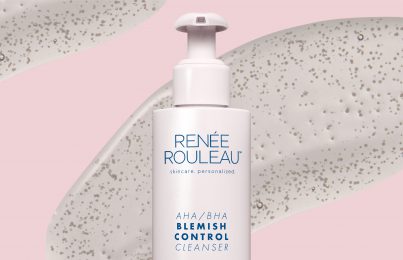Updated 08/21/23. A change in season typically means a change in the way the skin behaves. Take the transition from summer to fall, for instance. Dryness, dullness, and hyperpigmentation are all common during this time. Breakouts are too. In fact, as surprising as it may sound, breakouts can actually increase during the fall season. (Yes, really. Read all about fall breakouts and how to get rid of them).
No matter which skin issue you’re dealing with, know that you don’t have to overhaul your current skincare routine to address it. You just need to make some minor adjustments. Keep reading to learn eight ways to transition your skincare routine from summer to fall. Follow this advice, and your fall skincare routine will be easy and effective!
1. Switch Up Your Cleanser
Changing your cleanser is always my first recommendation when it comes to creating an effective fall skincare routine.
In the summer, certain foaming gel cleansers are great for use both morning and night. However, these cleansers may be too harsh once temperatures drop and less oil is being produced by the skin. This is especially true if you’re a Skin Type 7, 8, or 9 since these skin types are particularly prone to dryness and flakiness. (If you don’t know your skin type, take the Skin Type Quiz to find out.)
I recommend using a sulfate-free cleanser that barely lathers, like the Moisture Protecting Cleanser. As a general rule, the smaller the bubbles means the gentler it will be. You can also use a cream-based cleanser, like the Vitamin-Infused Cleansing Emulsion. I recommend using it at night to effectively remove dirt, sunscreen, and makeup from the skin.
2. Boost Hydration With a Toner
So many people overlook the use of toner. They think they’re simply not necessary, believing they don’t provide any real benefit to the skin, when, in reality, they provide five important benefits. If you’re not already using one, fall is a great time to start. That’s because the air is getting cooler but it’s not very dry yet, so your skin is likely in need of water-based hydration. That’s exactly what toners are for!
Start by cleansing your skin. Immediately follow up by wiping an alcohol-free toner over your skin (you only have 60 seconds to apply your next product after cleansing before water loss occurs, which is why it’s important to complete this step quickly. I call this the Golden Minute Rule). Once you’ve applied your toner, leave it damp on your skin and apply your next product, whether that’s a serum or moisturizer. This will seal in hydration and active ingredients.
3. Use a Heavier Moisturizer
A lightweight moisturizer is enough for most skin types throughout the summer. However, when the weather begins to change, and temperatures drop, consider using something a little heavier to prevent moisture loss. If you’re using a gel moisturizer, consider switching to a lotion, like Skin Recovery Lotion. If you’re already using a lotion, consider switching to a slightly more hydrating lotion, like Sheer Moisture Lotion. Finally, if you’re using a cream, consider switching to something with a thicker consistency and ingredients like ceramides or lipid-rich oils. For that, I recommend the Glow Enhancing Creme.
Using any moisturizer is better than none. Even people with breakout-prone skin need to use it. According to one study, people with breakout-prone skin had lower lipid levels in their skin compared to people who didn’t have breakouts. Fewer lipids translate to water loss and a compromised moisture barrier (not good!).
Another option is to use face oil (like the Renée Rouleau Pro Remedy Oil). The benefit of this is that you can add a few drops into the palm of your hand and pat it over your moisturizer as needed. This allows you to customize your moisturizer on days when you’re feeling drier than normal. When you’re not feeling dry, don’t use it! It’s that simple. Just make sure to use face oil the right way. I often see people use it incorrectly.
4. Protect Your Skin With SPF
Sunscreen is an incredibly important component of any fall skincare routine. That’s because fall is a season during which a tremendous amount of UV damage is incurred. We often think that when the temperatures are dropping, the sun isn’t as harmful, but this is false.
While UVB rays (the ones responsible for suntans and sunburns) are not as strong, UVA rays (the ones responsible for skin cancer and premature skin aging) are just as strong as they are in the summer months. That explains why sun protection is a year-round job. Be sure to apply sunscreen to your face, neck, and any exposed chest area every single day, rain or shine!
5. Reincorporate Retinol Into Your Routine
I recommend using retinol all year round if you can (you can read what that is, here). However, if you took a break from it during the summer, it’s time to reincorporate it into your skincare routine. Whether it’s non-prescription retinol or a prescription retinoid, it can help reduce the appearance of brown spots caused by the summer sun, as well as lines and wrinkles. I personally use this retinol serum faithfully. Before you start using retinol, read my beginners’ guide in order to prevent dry, flaky side effects.
6. Exfoliate to Remove Unwanted Pigment
Certain skin types are prone to increased sensitivity in the summer from heat and sun exposure. These skin types should exfoliate minimally during this time to help avoid unwanted irritation. Come fall, however, exfoliation is imperative to brighten the complexion and help reduce the appearance of discoloration brought out by the summer sun and heat.
I like using an at-home chemical peel and a well-formulated facial scrub. The latter is the most important. While the exfoliating acids in an at-home peel can dissolve and digest discolored cells, it’s the lifting action of a facial scrub that really works to help the skin appear more even in tone (learn more about the benefits of using a facial scrub).
There’s one more thing I want to mention. Exfoliating is essential to help reduce breakout activity. It does so by removing dead skin cells that trap oil. It can also encourage cellular turnover, replacing dull, tired-looking cells with fresher, plumper ones.
7. Switch Up the Type of Face Mask You Use
Gel masks hydrate the skin, which means they’re best for oily, breakout-prone skin types that are in need of water but no additional oil. Also, because of their naturally cool temperature, they’re ideal for soothing sensitivity and redness.
When it comes to a fall skincare routine, though, consider switching to a cream mask if you experience dryness. These types of masks contain moisturizing oils that can help out normal to dry skin types. The Pure Radiance Creme Masque is a great choice. It contains lipid-rich oils that replicate the skin’s natural internal moisturizers, which can help improve elasticity.
8. Listen to Your Skin
Regardless of the season, the skin (like the body) is constantly adapting to internal and external changes. It’s important to be attentive to your skin, so you can recognize when it’s not getting what it needs. Tightness, dryness, increased breakout activity, and sensitivity are all signs that your current skincare routine isn’t working and a change is in order. You always want to work with Mother Nature, never against her. So, when skin problems arise, make sure you’re using products that are formulated to address your specific needs! You can always schedule a consultation with a Renée Rouleau esthetician for guidance.
Next, learn the difference between dry and dehydrated skin.
Celebrity Esthetician & Skincare Expert
As an esthetician trained in cosmetic chemistry, Renée Rouleau has spent 30 years researching skin, educating her audience, and building an award-winning line of products. Her hands-on experience as an esthetician and trusted skin care expert has created a real-world solution — products that are formulated for nine different types of skin so your face will get exactly what it needs to look and feel its best. Trusted by celebrities, editors, bloggers, and skincare obsessives around the globe, her vast real-world knowledge and constant research are why Marie Claire calls her “the most passionate skin practitioner we know.”




Comments:
Hello Mrs. Rouleau my name is Vanessa, I have combination/ normal skin prone to small breakouts on cheek area my breakouts linger for some time and my skin gets drier on the winter time and I also have a small spot of redness on my upper cheek in one side what cleanser should I use? Can I use the moisture protecting cleanser? What other products do you recommend for my skin because my skin is confusing?
Posted By: Vanessa |
Hi Vanessa, The Moisture Protecting Cleanser can be used by any type of skin, it’s so incredibly gentle. I think you should look at the products for skin type #4.
Posted By: Renée Rouleau |
Ok thank you I will and for the moisturizer for the winter time I should use the Hawaiian nourishing cream instead of the skin recovering lotion?
Posted By: Vanessa |